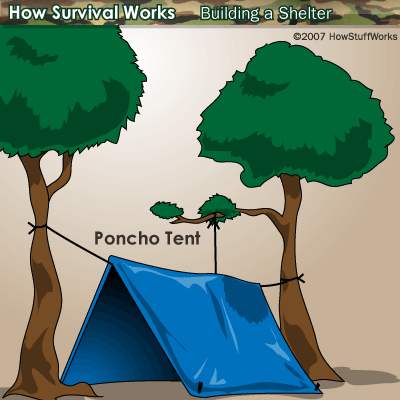It’s vital in any survival situation to make use of anything you find or already have with you. You can often find useful materials left behind by others. A bit of discarded climbing rope, some ripped plastic sheeting or even an old hiking boot can be of great use in the woods. You should always gather whatever you have or find and keep it at your base camp. Items like ponchos, nylon hammocks or parachutes can serve as shelter materials.
If you have a poncho or any kind of plastic sheeting, you can build several different types of shelters. What you want to do is mimic the shape of a tent. For a basic shade shelter, all you need to do is spread the material out so you can get under it. If you have some rope, you can tie it between four trees to form a canopy. You can fashion a tent shelter by running rope down the center of the poncho between two trees, then staking the sides into the ground with sharp sticks to create an A-frame. Another simple lean-to shelter can be made by tying two opposite corners of the poncho to trees. The other end slants diagonally to the ground and can be secured with stick stakes or heavy rocks.
If you don’t have any rope, build a one-person tent from tree branches:
- Take a forked tree branch and wedge it into the ground about a foot deep, with the “Y” pointing up.
- The ridgepole is the center ceiling support and should be straight and sturdy. Run it from the ground to the fork, resting in the “Y.”
- Create an “A” for the tent door by resting sturdy diagonal branches opposite each other that meet at the fork.
- Use vine or thin green branches to lash together all three support points.
- Create a ribbed frame with branches set diagonally along the ridgepole, wide enough so you have room inside.
- Once you have your frame built, drape your cover over the top and stake it down with sharp sticks.

This one-man tent is easy to build and provides good shelter from the elements.
If you have enough material and want to suspend yourself from the ground, you can create a cot. Find two long, sturdy branches and roll them into the material on each side like a long scroll, leaving about a foot of wood exposed at each end. Then simply lash the cot to four trees a few feet off the ground. Proceed aboard slowly, but your body weight should pull it tight as long as it’s wrapped with enough material.
Combine this above-ground cot with a cover to form an elevated platform. If you can’t find four trees in close enough proximity, use a single forked tree at one end to form a “Y”-shaped base. If you have rope but no tree to tie into, tie it around a medium sized rock and bury it 6 to 8 inches into the ground. If you tie rope or twine higher than the shelter, you should attach drip sticks. Just get a 6-inch stick and attach it to the line a few inches from where it meets the material. This allows the water to run down the stick instead of into your shelter.
Field Expedient Shelters
The U.S. military’s term for using natural objects to accomplish a task is field expedient (FE). If you’re lost or stranded in the wild and you have no materials at all, you’ll need FE tools and shelter.
FE shelters employ the same methods as ones built with ponchos or tarps. The only difference is what you use to cover the frame. After you build the frame, use branches and thicket to make up your roof. Pine boughs make for good insulation, but as long as you stack and weave lots of leaves, branches and twigs, you’ll have adequate shelter. Think of your shelter roof as being shingled like a house. Work in layers from the ground up and keep the branches pointed toward down for rainwater runoff.
A debris hut is an FE shelter that’s easy to build and provides great protection from the elements. To build one:
- Place a ridgepole, the pole that runs the length of the shelter, with one end on the ground and the other on top of a sturdy base like a tree stump or boulder. You can also lash it to a tree.
- Take two more thick branches and place them diagonally at the top of the ridgepole and lash them together with vine.
- Use thick branches to line the length of the ridgepole to create the ribbed frame. Make sure it’s wide enough to accommodate you.
- Place smaller sticks crosswise to make a lattice effect.
- Add lighter soft debris like pine needles and leaves until it’s at least two feet thick — the thicker the debris, the more protection it offers.
- Cover the interior floor with pine and leaves and block the entrance with a rock or more debris.
If you’re in deep snow and have large evergreen trees around, build a tree-pit snow shelter:
- Find a thick evergreen tree with low-hanging branches.
- Dig down into the snow to your preferred depth and diameter — the cozier the better.
- Pack the interior snow well.
- Use the natural branches above and add additional boughs for your cover.
- Use boughs as insulators on the interior floor.

A tree-pit snow shelter takes a lot of energy to build, but it’s a great insulator against frigid weather.
Whatever your emergency scenario, the most important thing is to remain calm and in control. Panic will get you nowhere and knowing some rudimentary survival skills can be the difference between life and death. Basic shelters are easy to build and crucial to surviving the harsh elements of the great outdoors. If you’re an avid camper or hiker, you should practice building a shelter on your next excursion. It can be educational, potentially life-saving and a lot of fun.
by Charles W. Bryant
howstuffworks
















